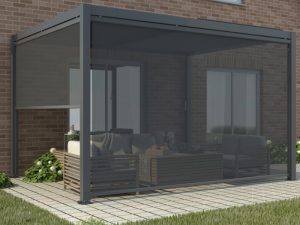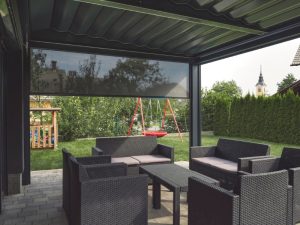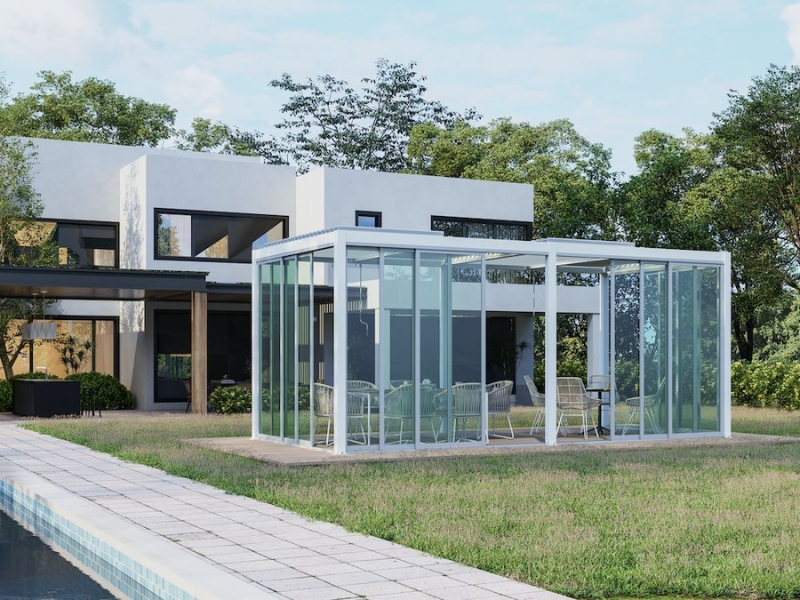Winter doesn’t mean the end of enjoying your pergola. With a few adjustments, you can turn your pergola into a cosy, functional space all year round. Whether you’re looking for extra shelter from the chill or creating a warm, inviting atmosphere, it’s possible to extend your pergola’s use throughout the colder months. This article will explore how to make your pergola a year-round outdoor living space feature.
What makes a pergola suitable for winter use?
Certain features can make all the difference when considering how to make your pergola winter-friendly. The right materials, design, and accessories can help you create a warm and functional space throughout the season.
- Sturdy structure: Pergolas designed with durable, weather-resistant materials like aluminium or steel can withstand harsh winter conditions.
- Retractable roofs: A pergola with a retractable roof can offer protection from rain and snow when needed, while providing an open space when the sun shines.
- Walls and screens: Adding retractable or fixed walls helps block the cold wind and snow.
- Heating options: Consider installing heaters to keep the area warm and comfortable.
- Good drainage: Ensuring water drains properly from your pergola roof prevents issues like ice build-up.
These features will help you enjoy your pergola even when the weather turns cold.
Do DIY pergola kits work well in winter?
Many homeowners are drawn to DIY pergola kits for their ease of installation and cost-effectiveness. But how well do they perform in winter? With a few key adjustments, DIY pergolas can be perfect for winter use.
- Material selection: Choose materials that withstand cold and moisture, such as powder-coated aluminium or treated timber.
- Installation of clear panels: Adding clear acrylic or polycarbonate panels can keep the wind at bay while letting in natural light.
- Weatherproof finishes: Ensure that the finish on your DIY pergola is weather-resistant and won’t degrade in winter conditions.
- Proper drainage: Ensure water doesn’t collect on the pergola roof, which could cause damage during freezing conditions.
- Insulation options: You can easily add insulation to the underside of the roof to help maintain warmth in the area.
With these considerations, DIY pergola kits can be a practical solution for enjoying your outdoor space in winter.
When is the best time to prep your pergola for winter?
Understanding Australian climate zones is key to preparing your pergola for winter, ensuring it remains safe, durable, and functional throughout the colder months. The best time to prep is usually before the chill sets in, giving you ample time to make any necessary adjustments.
- Autumn cleaning: Clean the pergola thoroughly to remove leaves, debris, and dirt that could cause damage over time.
- Inspect for damage: Check for any cracks, loose bolts, or structural issues that need attention.
- Weatherproofing: Apply a weatherproof sealant to protect the wood or metal from the elements.
- Install screens and panels: Add weather-resistant screens or panels to protect the pergola from wind and rain.
- Install heating options: If you plan to use your pergola in winter, consider installing outdoor heaters before the weather turns cold.

Preparing ahead of time ensures your pergola is ready for whatever winter throws.
What winter accessories improve pergola comfort?
Winter accessories can enhance your pergola experience by adding warmth, privacy, and protection from the elements. Here are some accessories to consider for your pergola:
- Outdoor heaters: Freestanding or mounted outdoor heaters are perfect for adding warmth to your pergola.
- Side panels or curtains: Adding outdoor curtains or panels offers privacy and shields you from cold winds.
- Fire pit or fireplace: A fire pit or small outdoor fireplace creates a cosy atmosphere and keeps you warm.
- Blankets and throws: Keep a few warm blankets nearby when temperatures drop.
- Fairy lights or lanterns: Adding lighting to your pergola safely creates a cosy ambience and can make the space feel more inviting during the dark winter nights.
These simple accessories can transform your pergola into a warm, inviting retreat all winter.
Which pergola features help most in cold weather?
Some pergola designs and features are particularly suited for winter weather. These features ensure your pergola remains comfortable and functional throughout the colder months.
Feature | Function | Benefit |
Louvered roofs | Adjustable cover | Sun/rain/snow control |
Clear panels | Enclosed sides | Cold air protection |
Retractable screens | Wind-blocking barrier | Outdoor visibility |
Insulated roofs | Thermal ceiling | Warmer environment |
Windbreaks | Draft protection | Maintains warmth |
These features make your pergola a more viable outdoor space in winter, providing warmth, comfort, and shelter.
Can you use a pergola all year round?
Yes, you can use your pergola all year round with a few adjustments. Pergolas are generally versatile structures, but taking a few extra steps ensures comfort through all seasons, including winter.
- Seasonal accessories: Add removable screens, heaters, or lighting as necessary to make your pergola comfortable in winter.
- Custom roofing options: Install a roof that can be adjusted according to the weather, providing protection from summer sun and winter snow.
- Proper drainage: Ensure your pergola is well-constructed with adequate drainage to handle rain, snow, and ice.
- Protective covers: When the pergola isn’t in use, use protective covers to protect it from harsh weather elements.

By incorporating a few budget-friendly ways to enhance your pergola with seasonal features, you can enjoy it year-round.
Are there any maintenance tips for a pergola in winter?
Winter can be tough on outdoor structures, and your pergola is no exception. Proper maintenance ensures your pergola stays in excellent condition through the cold months.
- Remove snow and ice: Regularly clear snow or ice off the roof and surfaces to prevent weight damage or ice build-up.
- Check for leaks: Ensure no leaks, especially around roofing panels or screens, could let in moisture or cold air.
- Protect the wood: If you have a wooden pergola, apply a weatherproof sealant to protect it from moisture damage.
- Inspect structural integrity: Regularly check for signs of wear or loose bolts, as cold temperatures can cause materials to expand and contract.
- Cover furniture: If you have outdoor furniture, cover it or bring it indoors to prevent damage from the cold.
With these maintenance tips, your high-quality and durable pergola will remain a reliable and enjoyable space, no matter how cold it gets outside.
Conclusion
You can continue enjoying your pergola throughout the winter months with proper preparation and thoughtful additions. Whether sipping a warm drink, hosting a small gathering, or simply relaxing outdoors, a winter-ready pergola can make all the difference. Keep it well-maintained, and you can maximise its use all year round.
Curious about enhancing your outdoor space? Discover what Unique Pergolas can offer to transform your area.


